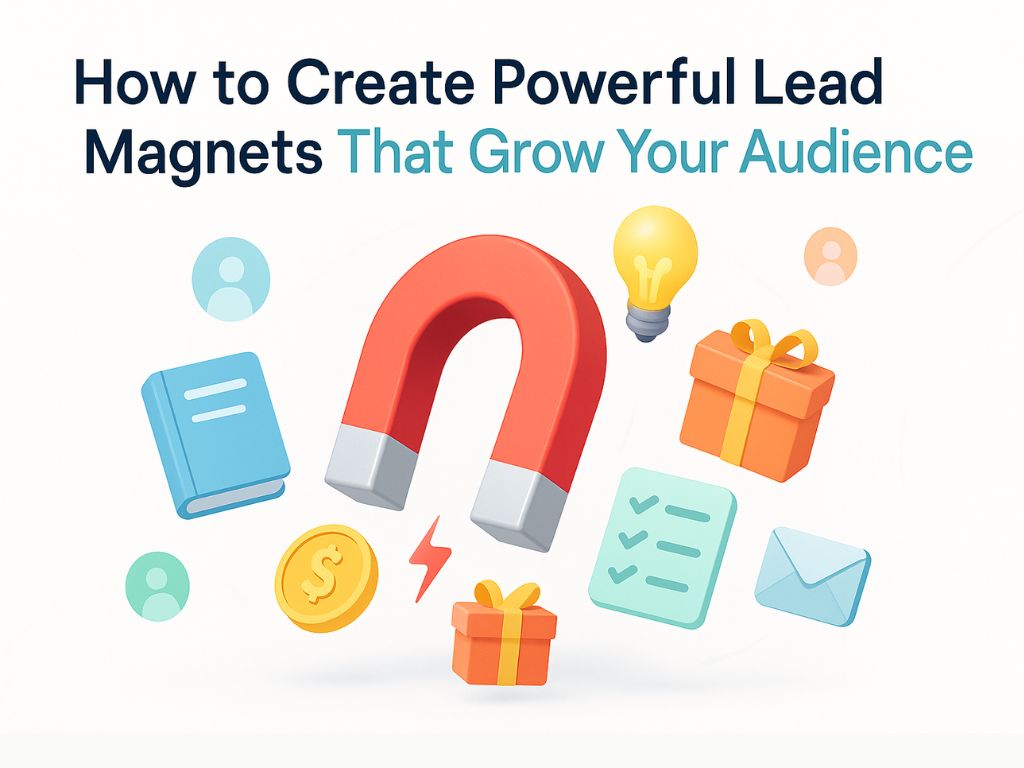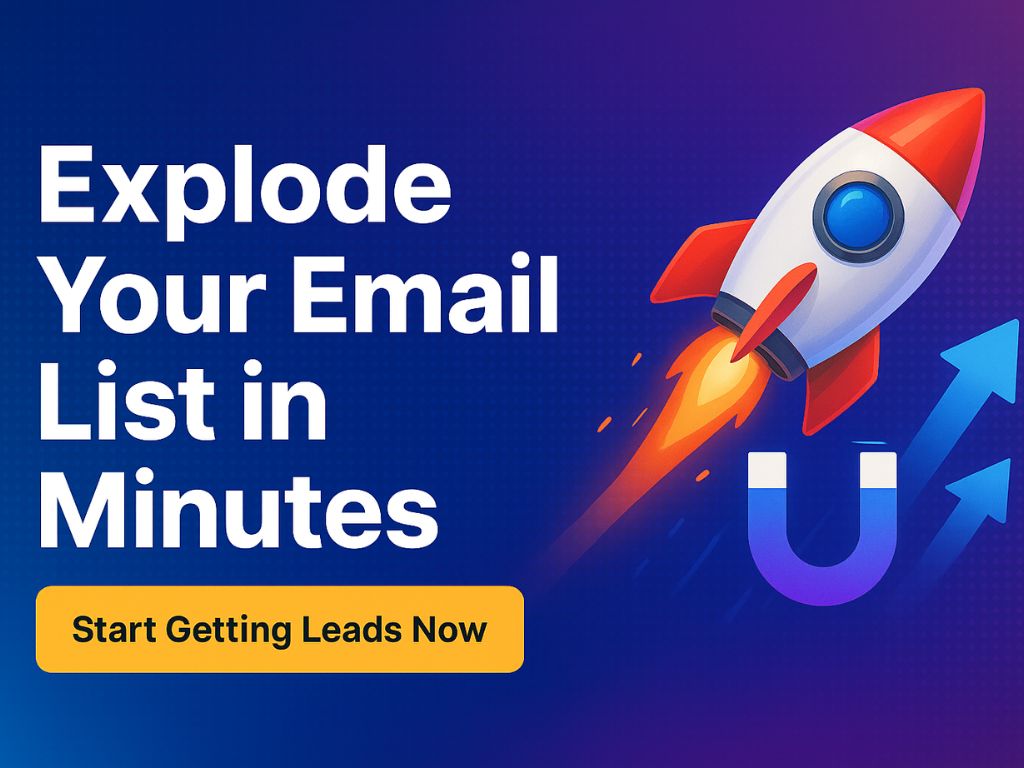Introduction
Every great email list starts with one thing most creators overlook an offer people actually want. That offer is your lead magnet, the bridge between curiosity and commitment. It’s what transforms passive visitors into willing subscribers, one valuable promise at a time.
In a world where attention is scarce and inboxes are full, lead magnets remain one of the few strategies that still work when done right. This guide will show you what they are, why they work, and how to create one that attracts subscribers consistently.
By the end, you’ll know exactly how to design, deliver, and optimize a lead magnet that builds trust and turns interest into action.
Key Takeaways
Lead Magnets That Actually Convert in 2025
- A lead magnet is a focused resource offered in exchange for contact information, designed to start a trust-based relationship.
- The strongest lead magnets solve one clear problem for a specific audience, not a broad promise for everyone.
- Simplicity, clarity, and immediate value consistently outperform long or complex resources.
- Formats such as checklists, templates, quizzes, and mini-courses remain top performers in 2025.
- High-converting lead magnets are built on psychology: relevance, reciprocity, and micro-commitment.
- The right tools simplify design, automate delivery, and measure performance with minimal effort.
- Effective creators avoid common mistakes by keeping promises precise, design clean, and delivery seamless.

What is a Lead Magnet and Why It Matters
A lead magnet is a focused, high-value resource offered to potential subscribers in exchange for their email address or other contact details. It acts as a handshake, a small but meaningful exchange that starts a relationship built on trust. The promise is simple: you give immediate value, and in return, the visitor gives permission to continue the conversation.
What separates a true lead magnet from a generic freebie is intent. A random free download might attract clicks, but a strategic lead magnet attracts qualified leads people who are genuinely interested in what your business offers next. It bridges the gap between awareness and action, guiding prospects one step closer to becoming customers.
For growing businesses, the value of that exchange compounds over time. Every download adds to a list of people who’ve already shown interest, making it easier to nurture relationships, test offers, and convert sales later. It’s not about collecting contacts; it’s about building an audience that trusts you.
According to HubSpot’s 2025 Marketing Insights Report and supporting industry benchmarks, lead magnets remain one of the highest-performing lead generation tactics, with high-quality, targeted landing pages often converting above the 18% average.
You’ve Been Creating for Attention. Now Create for Conversion.
Transform your ideas, posts, and videos into irresistible lead magnets each one designed to grow your audience and your sales.
Why Lead Magnets Work: The Psychology Behind the Exchange
At their core, lead magnets work because they tap into a simple human truth: people are willing to share something valuable when they believe they’re getting something valuable in return. This is the principle of reciprocity. When your lead magnet delivers a quick win, the exchange feels natural, not transactional.
The effect goes deeper than just the giveaway. A well-crafted lead magnet also builds micro-commitment, a small “yes” that paves the way for bigger ones later. By accepting your resource, the subscriber has already taken the first step in your funnel. That action shifts them from passive reader to active participant, increasing the likelihood they’ll open future emails or engage with your offers.
Relevance and timing amplify that effect. When your lead magnet addresses a real pain point at the exact moment someone is searching for a solution, the perceived value spikes. It feels personal, almost intuitive. That’s what makes the difference between another free download and a tool that genuinely builds trust.
The final layer is authority. A lead magnet that demonstrates expertise without overpromising positions you as a reliable source. When people associate your brand with clarity and usefulness, they’re far more likely to engage again.
According to conversion optimization principles from the CXL Institute, conversions rise significantly when the lead magnet offer aligns precisely with a visitor’s immediate intent and perceived need, reinforcing that psychological relevance drives higher opt-in rates.

The Most Effective Types of Lead Magnets in 2025
Not every lead magnet performs equally well. The most effective ones meet two criteria: they solve a specific problem and they deliver value instantly. Formats have evolved, but the core principle hasn’t changed, clarity and usefulness always win.
Guides and eBooks remain reliable because they provide depth and authority. When well-written and tightly focused, they position you as a trusted educator. The key is brevity; short, actionable insights outperform long documents that feel like work to read.
Templates and checklists convert exceptionally well because they save time. Audiences love ready-made solutions that reduce friction. A checklist that walks them through a process, or a template that simplifies creation, creates immediate satisfaction.
Quizzes and calculators are gaining momentum as interactive options. They engage users by offering personalized results, a tailored outcome based on their inputs. That level of relevance makes people feel understood, which deepens their connection to your brand.
Mini-courses and challenges perform strongly when nurturing deeper engagement. A short email series or three-day challenge builds momentum through repeated interaction. Each touchpoint reinforces trust, leading naturally into your product ecosystem.
Exclusive resources like spreadsheets, swipe files, or toolkits appeal to experienced audiences who value shortcuts. These resources carry higher perceived value because they resemble what professionals use internally.
Each type serves a different stage of the customer journey, but all effective lead magnets share one trait: they give real, practical value before asking for anything in return.

How to Create a High-Converting Lead Magnet
A high-performing lead magnet starts with strategy, not design. The goal is to create something your audience already wants, then deliver it in a format that feels effortless to consume. Each step in this process matters because every element either builds trust or creates resistance.
1. Identify your audience’s most urgent problem.
A lead magnet that doesn’t solve a specific pain point will fail, no matter how well it’s designed. Begin by listening surveys, search data, and comment threads reveal what your audience struggles with most. The clearer the problem, the stronger the conversion potential.
2. Choose the right format for that problem.
Different issues require different delivery methods. If your audience wants clarity, a checklist works best. If they need step-by-step guidance, use a guide or template. Avoid overcomplicating; the right format is the one that gets them a result quickly.
3. Craft a promise-driven title.
Your lead magnet’s title is its first conversion test. Focus on the result, not the resource. Instead of “Email Marketing eBook,” say “How to Write Emails That Get Replies.” Clarity beats cleverness because readers instantly recognize the benefit.
4. Design for simplicity and visual flow.
Readable typography, clean spacing, and clear hierarchy keep users engaged. The goal is to make the resource scannable and actionable. If you need help with layout or formatting, see our companion guide on Lead Magnet Tools, where we compare the best software for design, delivery, and automation.
5. Deliver seamlessly and follow up.
Once your magnet is ready, make the exchange effortless. The opt-in form should be short, the download immediate, and the confirmation email personal. Use automation to deliver quickly and maintain engagement from the first message onward.
When every step aligns with your reader’s intent, your lead magnet stops feeling like a marketing tactic and starts functioning as a genuine solution. That’s what earns trust and trust is what converts.

Tools to Build and Deliver Your Lead Magnets
Even the best idea can fail if your tools slow you down. The right software makes it easy to design, deliver, and track your lead magnet without technical friction or manual work. Choosing tools is less about features and more about how well they fit your workflow.
Design tools help you present your content clearly and attractively. Platforms like Canva, Beacon, and Visme simplify the design process with templates, brand kits, and drag-and-drop layouts. The goal is visual clarity, not decoration. A clean layout communicates professionalism and keeps readers focused on your message.
Delivery tools automate the process of getting your resource into the subscriber’s hands. Email service providers such as ConvertKit, ActiveCampaign, and MailerLite let you send files instantly after signup. Fast delivery reinforces trust — when people receive what you promised immediately, they’re more likely to engage with future messages.
Automation tools connect your lead magnet to the rest of your marketing system. Services like Zapier or Make integrate forms, email platforms, and CRMs, removing repetitive manual steps. Automation ensures that leads are captured, tagged, and nurtured automatically, so no opportunity is missed.
Analytics tools measure how well your lead magnets perform. Google Analytics, Fathom, and native ESP reports show which opt-ins attract the most engagement. These insights reveal where to improve design, placement, or messaging for higher conversion.

Common Mistakes to Avoid When Creating Lead Magnets
Even strong strategies fail when small missteps compound. Most lead magnets underperform not because the idea is weak, but because execution misses a few key fundamentals. Recognizing these errors early keeps your list-building system efficient and credible.
The first mistake is misalignment between topic and audience. Many creators design what they want to give away instead of what people actually need. When the offer doesn’t match the reader’s pain point, even great content won’t convert. Always start with audience data, not assumptions.
A second mistake is overcomplication. A lead magnet should deliver one result clearly and quickly. Adding too much information, too many pages, or too many steps dilutes impact. Simplicity is not a compromise; it’s a competitive advantage.
Weak design is another silent conversion killer. Poor formatting, inconsistent visuals, or confusing navigation signal low quality. The reader subconsciously assumes your paid offers will feel the same. Clear design equals credibility, even in a free resource.
Some creators also overlook delivery and follow-up. If subscribers wait too long to receive their download or never hear from you again, the connection fades instantly. Fast delivery and thoughtful nurturing sustain momentum.
Finally, avoid vague promises. A lead magnet titled “Improve Your Marketing” doesn’t say enough. Precision builds confidence. Tell readers exactly what they’ll achieve and then deliver on that promise without exaggeration.
A good lead magnet feels intentional, not accidental. When each part; topic, design, delivery, and follow-up aligns with audience needs, conversions become predictable instead of lucky.

Conclusion
Lead magnets remain one of the most reliable ways to grow an audience because they start the relationship with value, not persuasion. When created with clarity and genuine intent, they attract subscribers who are already interested in what you offer next.
The key is precision. Know your audience, define one problem, and solve it completely. The smaller the promise, the easier it is to fulfill and the faster trust builds.
Tools and tactics will evolve, but the principle stays constant: people exchange information only when they believe the benefit is real. Keep your offer relevant, your design clear, and your delivery seamless.
What matters most isn’t the format you choose, but the promise you keep. Clarity converts. Value retains. Your lead magnet is your first impression, make it the most honest, useful thing your brand creates.

FAQs: Lead Magnets
How long should a lead magnet be?
There’s no fixed length, only a fixed purpose. A good lead magnet should be long enough to solve one problem completely and short enough to consume in one sitting. Most high-performing resources take between five and fifteen minutes to finish.
What format works best for beginners?
Simple formats such as checklists, templates, or short guides are ideal for beginners. They’re fast to create, easy to deliver, and immediately useful for the audience. Complexity rarely improves performance in early stages.
Can I reuse the same lead magnet on different platforms?
Yes, as long as the audience intent is the same. A resource designed for website visitors can also work on social media or paid ads, provided the promise matches the context. Adjust your headline and landing copy to fit each channel’s tone and format.
How do I know if my lead magnet is effective?
Track opt-in rates, download completions, and email engagement over time. A strong lead magnet consistently attracts new subscribers who stay active beyond the first message. According to industry conversion data cited by OptinMonster, a lead magnet landing page conversion rate of 30% or higher is considered excellent performance, far surpassing the typical average of around 18%
Should I create multiple lead magnets or focus on one?
Start with one high-quality lead magnet that fits your main offer. Once it performs consistently, create new ones for different audience segments or entry points. Depth builds credibility; variety expands reach.
How often should I update my lead magnet?
Update your lead magnet whenever its information, examples, or tools become outdated. A light refresh every six to twelve months keeps it relevant and trustworthy. Outdated content signals neglect and can quietly erode credibility.
Can I gate my lead magnet without hurting SEO?
Yes. Search engines can index the landing page even if the download itself is gated. The key is to include enough context, value, and descriptive content on the page so it still ranks for relevant keywords.
What’s the best way to promote a new lead magnet?
Promote it across all owned and earned channels your homepage, blog posts, social media, and email signature. Tie it contextually to high-traffic content where it feels like a natural next step. Relevance outperforms reach.
Pingback: Lead Magnet Software: Grow Your Email List Faster - Lead Magnets Creator
Pingback: How to Use Swipe Files to Grow Your Email List Fast - Lead Magnets Creator
Pingback: Lead Magnets for Affiliate Marketing: How to Boost Conversions - Lead Magnets Creator
Pingback: AI-Powered Lead Magnets That Actually Convert - Lead Magnets Creator